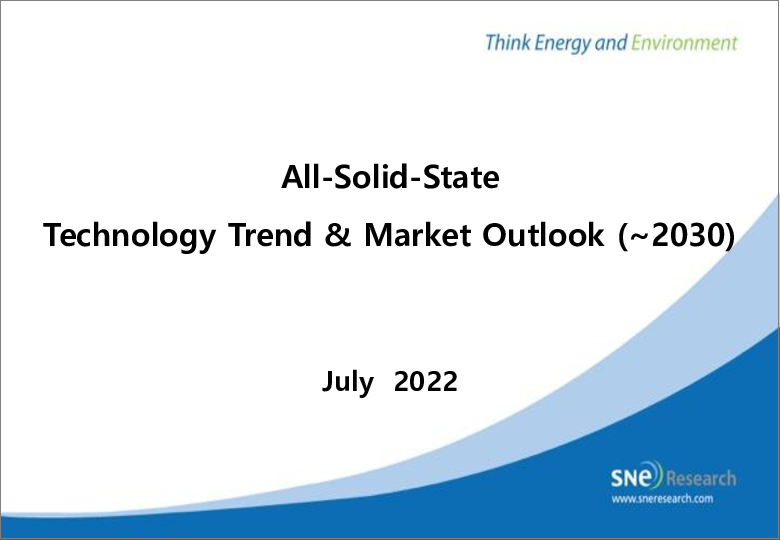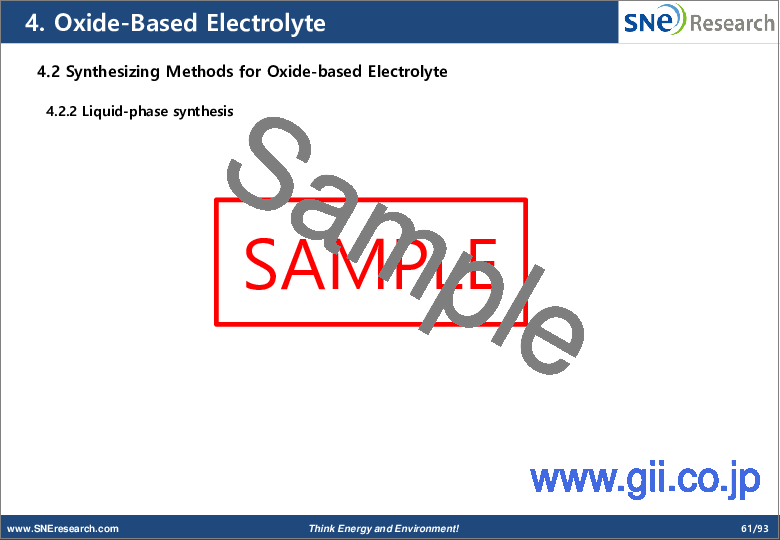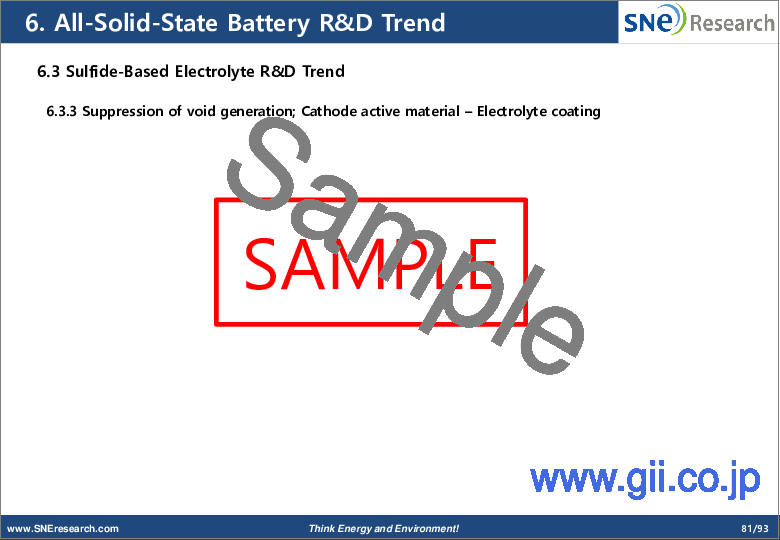|
|
市場調査レポート
商品コード
1068491
全固体電池の技術現状と2030年までの市場展望(2022年)<2022> Technology Status and Market Outlook of All-Solid-State Battery (~2030) |
||||||
| 全固体電池の技術現状と2030年までの市場展望(2022年) |
|
出版日: 2022年04月06日
発行: SNE Research
ページ情報: 英文 222 Pages
納期: お問合せ
|
- 全表示
- 概要
- 目次
LiBの安定性やエネルギー密度に関する課題が次々と浮上する中、それらの課題を解決する次世代電池の開発に関心が高まっています。中でも全固体電池は、安定性や開発対応力の面で、業界関係者から最も注目されています。
当レポートでは、全固体電池市場について調査し、各タイプの長所・短所や課題、製造プロセスの詳細な解説、各電池メーカーの主な市場開拓と成果、2030年までの各タイプの市場展望などの情報を提供しています。
目次
第1章 イントロダクション
- 電池開発の歴史
- 以前の電池開発の歴史
- マンガン電池(ルクランシェ電池)
- アルカリ電池
- 鉛蓄電池
- ニカド電池
- ニッケル水素電池
- リチウムイオン電池
- リチウムイオン電池の課題
- 安全性
- エネルギー密度
第2章 全固体電池
- 全固体電池のメリット
- 全固体電池の製造工程
- 固体電解質
- 全固体電池が既存のSCMに与える影響
第3章 硫化物ベースの電解質
- 硫化物系電解質の種類
- 硫化物系電解質の合成法
- コア原料の合成法
第4章 酸化物系電解質
- 酸化物系電解質の種類
- 酸化物系電解質の合成法
第5章 ポリマーベースの電解質
- ポリマー系電解質の種類
- 高分子系電解質の合成法
第6章 全固体電池の研究開発動向
- 全固体電池の問題点
- 全固体電池の研究開発動向
- Li金属の安定性の向上
- 電極結合能力の向上
- 極板製造工程の改善
- 硫化物系電解質の研究開発動向
- 固体電解質・電極の界面安定性の向上
- 粒子分離の改善
- ボイド発生抑制
- 固体電解質の性能向上
- 酸化物系電解質の研究開発動向
- 固体電解質/電極接触の改善
- 固体電解質の性能向上
- 高分子電解質の研究開発動向
- 電解質層の自立性の向上
- Liデンドライト形成の抑制
第7章 全固体電池の特許動向
- 全固体電池特許の概要
- ポリマータイプの主な特許
- 無機、有機/高分子ハイブリッドの主な特許
- 全固体電池の特許 - 原材料
- 全固体電池特許 - 電池応用
- 全固体電池材料のコア特許
第8章 ASB開発者の現状
- アジア
- Samsung Electronics
- Korea Institute of Industrial Technology
- LG Chem
- SK Innovation
- Hyundai Motors
- Seven King Energy
- Toyota
- Hitachi Zosen
- TDK
- Ohara
- Murata
- Idemitsu Kosan
- APB
- FDK
- NGK SPARK PLUG
- Taiyo Yuden
- CATL
- Prologium
- Ganfeng Lithium
- TDL
- Coslight
- Welion New Energy
- BYD
- Daejoo Electronic Materials
- ISU Chemical
- CIS
- Hannong Hawseong
- 欧州
- Ilika
- Blue Solutions
- IMEC
- Embatt
- Innolith
- Saft
- 北米
- Solid Power
- Solid Energy Systems
- 24M
- Hydro Québec
- Sakti3
- SEEO
- Brightvolt
- Ionic Materials
- TeraWatt
- QuantumScape
- Infinite Power Solution
- Prieto
- Factorial
- Amprius
- EoCell
- Cymbet
- Johnson energy storage
- 全固体電池開発における共同パートナーシップの現状
- 地域別支援機関の状況
- 国際政府資金による国際協力
- アジアの主要代理店
- 欧州の主要代理店
- 北米の主要代理店
- 地域別支援制度
- 日本
- 欧州
第9章 SNEの洞察
- 電解液の種類別デメリット(大面積電池)
- 異なる電解質の課題と開発の方向性
- 各種電池(ハイブリッド・半固体)
- 企業別全固体電池の量産時代
- 全固体電池アノード/カソードの現状と未来
- 全固体電池タイプ(酸化物/硫化物/ポリマー)間の競争
- 全固体電池のさまざまな用途
- 全固体電池生産設備のイメージ
第10章 全固体電池市場の展望
- 概要
- 市場の見通し
With the issues related to the stability and energy density of LiB continuously emerging in the industry, there are growing interests in developing next-generation batteries to address those issues. Among them, the all-solid-state battery has been attracting the biggest attention from the industry players in terms of stability and development readiness.
The all-solid-state battery can be categorized into three types: sulfide-based, oxide-based, and polymer-based. Each type has different advantages/disadvantages and pending issues. This report describes the advantages/disadvantages and issues related to each type as well as the details of their manufacturing processes. Furthermore, this report explores the major developments and achievements made by each battery maker and offers a market outlook for each type till 2030.
This report draws market estimates from comprehensive research on the level of technology development, requirements by OEMs and mass production targets of all-solid-state battery makers. The market analysis provided in this report is categorized into battery maker types, companies, and applications.
All of the above are provided in 10 chapters of which brief indexes are as stated in the following table of contents.
To provide a deeper insight, the 2022 report adds the SNE Insight chapter which deals with the challenges facing different electrolytes and tries to guide directions for their improvement. The chapter also investigates Semi Solid/Hybrid batteries and the mass production time and targets of different battery makers. The report is all the more meaningful as it offers a more detailed market outlook than the 2021 edition, based on the current status and future plans of all-solid-state battery developers.
Table of Contents
1. Introduction
- 1.1. History of Battery Development
- 1.1.1. History of Ancient Battery Development
- 1.1.2. Manganese Battery (Leclanché cell)
- 1.1.3. Alkaline cell
- 1.1.4. Lead-acid battery
- 1.1.5. Ni-Cd battery
- 1.1.6. Ni-MH battery
- 1.1.7. Lithium-ion battery
- 1.2. Challenges with Lithium-Ion Battery
- 1.2.1. Safety
- 1.2.2. Energy Density
2. All-Solid-State Battery
- 2.1. Advantages of All-Solid-State Battery
- 2.1.1. Increase of Energy Density
- 2.1.2. Availability in Application of New Active Materials
- 2.1.3. Low Activation Energy
- 2.2. Manufacturing Process of All-Solid-State Battery
- 2.2.1. Manufacturing of Electrolyte Layers
- 2.2.2. Production of Anode and Cathode Composite Layers
- 2.2.3. Cell Assembly
- 2.3. Solid Electrolyte
- 2.3.1. History of Solid Electrolyte Development
- 2.3.2. Operation Mechanism of Solid Electrolyte
- 2.3.3. Classification of Solid Electrolyte
- 2.4. Influences of All-Solid-State Battery on Existing SCMs
3. Sulfide-Based Electrolyte
- 3.1. Types of Sulfide-Based Electrolyte
- 3.1.1. Thio-LISICON-based
- 3.1.2. Binary sulfide-based
- 3.1.3. Argyrodite-based
- 3.1.4. Others: Li7P2S8I
- 3.2. Synthesizing Methods for Sulfide-Based Electrolyte
- 3.2.1. Solid-phase Synthesis
- 3.2.2. Liquid-phase Synthesis
- 3.2.3. Wet-chemical Synthesis
- 3.3. Synthesizing Methods for Core Raw Materials
- 3.3.1. Core Raw Materials: Li2S
- 3.3.2. Synthesis of Starting Materials
- 3.3.3. Starting Material: Li metal
- 3.3.4. Starting Material: Li2SO4
- 3.3.5. Starting Material: Li2CO3
- 3.3.6. Starting Material: LiOH
- 3.3.7. Starting Material: Li-R
4. Oxide-Based Electrolyte
- 4.1. Types of Oxide-Based Electrolyte
- 4.1.1. Perovskite-based
- 4.1.2. Garnet-based
- 4.1.3. NASICON-based
- 4.1.4. Li1+xAlxGe2-x(PO4)3 (LAGP)
- 4.1.5. Others: Li2.9PO3.3N0.46 (LiPON)
- 4.2. Synthesizing Methods for Oxide-Based Electrolyte
- 4.2.1. Solid-phase Synthesis
- 4.2.2. Solid-phase Synthesis
5. Polymer-Based Electrolyte
- 5.1. Types of Polymer-Based Electrolyte
- 5.1.1. PEO-based Electrolyte
- 5.1.2. Polymer/Ceramic Composite
- 5.2. Synthesizing Methods for Polymer-Based Electrolyte
- 5.2.1. Blending method - PEO-based Electrolyte
- 5.2.2. Blending method - Polymer/Ceramic Composite
6. All-Solid-State Battery R&D Trend
- 6.1. Problems of All-Solid-State Battery
- 6.2. All-Solid-State Battery R&D Trend
- 6.2.1. Enhancement of Li metal stability
- 6.2.2. Improvement of Electrode Binding Capacity
- 6.2.3. Improvement of Pole Plate Manufacturing Process
- 6.3. Sulfide-Based Electrolyte R&D Trend
- 6.3.1. Improvement of Interfacial Stability of Solid Electrolyte/Electrode
- 6.3.2. Improvement of Particle Segregation
- 6.3.3. Suppression of Void Generation
- 6.3.4. Improvement of Solid Electrolyte Performance
- 6.4. Oxide-Based Electrolyte R&D Trend
- 6.4.1. Improvement of Solid Electrolyte/Electrode Contact
- 6.4.2. Improvement of Solid Electrolyte Performance
- 6.5. Polymer-Based Electrolyte R&D Trend
- 6.5.1. Enhancement of Self-standing Characteristics of Electrolyte Layers
- 6.5.2. Suppression of Li Dendrite Formation
7. Trend of All-Solid-State Battery Patents
- 7.1. Outline of All-Solid-State Battery Patents
- 7.2. Polymer-type Major Patents
- 7.3. Inorganic, Organic/Polymer Hybrid Major Patens
- 7.4. All-Solid-State Battery Patents - Raw Materials
- 7.5. All-Solid-State Battery Patents - Battery Application
- 7.6. Core Patents by All-Solid-State Battery Material
8. Current Status of ASB Developers
- 8.1. In Asia
- 8.1.1. Samsung Electronics
- 8.1.2. Korea Institute of Industrial Technology
- 8.1.3. LG Chem
- 8.1.4. SK Innovation
- 8.1.5. Hyundai Motors
- 8.1.6. Seven King Energy
- 8.1.7. Toyota
- 8.1.8. Hitachi Zosen
- 8.1.9. TDK
- 8.1.10. Ohara
- 8.1.11. Murata
- 8.1.12. Idemitsu Kosan
- 8.1.13. APB
- 8.1.14. FDK
- 8.1.15. NGK SPARK PLUG
- 8.1.16. Taiyo Yuden
- 8.1.17. CATL
- 8.1.18. Prologium
- 8.1.19. Ganfeng Lithium
- 8.1.20. TDL
- 8.1.21. Coslight
- 8.1.22. Welion New Energy
- 8.1.23. BYD
- 8.1.24. Daejoo Electronic Materials
- 8.1.25. ISU Chemical
- 8.1.26. CIS
- 8.1.27. Hannong Hawseong
- 8.2. In Europe
- 8.2.1. Ilika
- 8.2.2. Blue Solutions
- 8.2.3. IMEC
- 8.2.4. Embatt
- 8.2.5. Innolith
- 8.2.6. Saft
- 8.3. In North America
- 8.3.1. Solid Power
- 8.3.2. Solid Energy Systems
- 8.3.3. 24M
- 8.3.4. Hydro Québec
- 8.3.5. Sakti3
- 8.3.6. SEEO
- 8.3.7. Brightvolt
- 8.3.8. Ionic Materials
- 8.3.9. TeraWatt
- 8.3.10. QuantumScape
- 8.3.11. Infinite Power Solution
- 8.3.12. Prieto
- 8.3.13. Factorial
- 8.3.14. Amprius
- 8.3.15. EoCell
- 8.3.16. Cymbet
- 8.3.17. Johnson energy storage
- 8.4. Current Status of Joint Partnership for All-Solid-State Battery Development
- 8.5. Status of Supporting Agencies by Region
- 8.5.1. Global Cooperation Through Inter-national Government Funding
- 8.5.1. Major Agencies in Asia
- 8.5.2. Major Agencies in Europe
- 8.5.3. Major Agencies in North America
- 8.6. Support Programs by Region
- 8.6.1. Japan
- 8.6.2. Europe
9. SNE Insight
- 9.1. Drawbacks of Electrolyte by Type (Large-area Battery)
- 9.2. Challenges and Development Direction for Different Electrolytes
- 9.3. Various Types of Batteries (Hybrid/Semi Solid)
- 9.4. Time of All-Solid-State Battery Mass Production by Companies
- 9.5. Current Status and Future Direction of All-solid-state Battery Anode/Cathode
- 9.6. Competition Amongst All-Solid-State Battery Types (Oxide/Sulfide/Polymer)
- 9.7. Various Applications of All-Solid-State Battery
- 9.8. Images of All-Solid-State Battery Production Facilities
10. All-Solid-State Battery Market Outlook
- 10.1. Overview
- 10.2. Market Outlook




